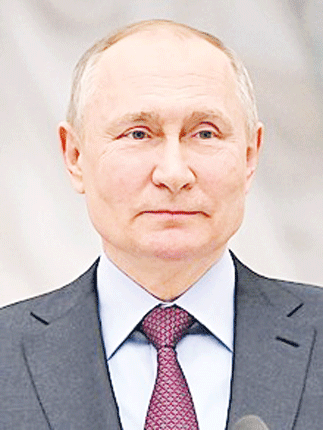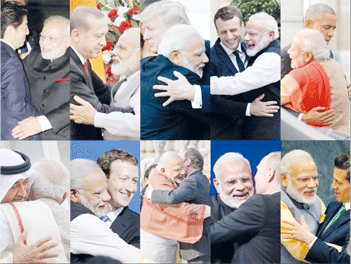NO HUGS: World leaders now dread Narendra Modi’s passion for giving them bear hugs out of fear that he could be a Covid-19 carrier!
Narendra Modi, who had built up a powerful global image for himself and the country, has got downsized due to his support of Russia over Ukraine.
By Priyanjali Malik
In Nehru’s view, India’s history, her variety, her unruliness and her great inequalities gave her the right to seek a global role in which all could rise together. Modi, however, sees global politics as a backdrop for his and the BJP’s domestic ambitions
India is standing at a crossroads when it comes to the war in Ukraine. Unlike Israel and Turkey, who are trying to use their relatively benign responses to Russia’s invasion to provide space for negotiating peace, India has not attempted any initiative to carve out a global role for itself in what is already the worst crisis in Europe since the Second World War. New Delhi has called for a ceasefire and dialogue, but done nothing to bring it about.
Further muddying this picture of diplomatic paralysis – played against a backdrop of frenetic visits and calls from high-ranking politicians and diplomats from the Quad, including the Prime Ministers of Japan and Australia – is this perverse impression that the invasion of Europe’s second-largest country by its largest country is somehow a standoff between Russia and the United States. And Indian sympathies, it seems, lie with Russia for the sake of their shared history. But which history is India looking at?
The Indo-Russian diplomatic record
all depends on where you look. The Soviet veto undoubtedly sheltered India over Kashmir when it was used in 1957 and 1962; the subsequent implied threat of its use also kept Kashmir off the agenda of the Security Council. By 1991, when Moscow informed New Delhi that it would no longer be able to offer the same sort of cover at the UN, the appetite of the other permanent members to tackle Kashmir had waned considerably and India had largely succeeded in its insistence that its differences with Pakistan were a bilateral issue.
However, the Soviet Union was less reliable over China. When the Chinese marched into India in 1962, not only did Moscow not respond to calls for help, citing its preoccupation with the Cuban Missile Crisis; it warned India that if New Delhi raised the issue at the Security Council, Soviet support would go to China. Moscow had also earlier suspended the sale of aircraft to India in a show of neutrality between the two.
The help that India sought came from the United States. Even though (US President John F.) Kennedy was equally preoccupied with events in Cuba, he convened a presidential meeting to discuss the two letters that Nehru sent him on November 19, 1962. Nehru had sought arms, American-manned fighter jets and military help that virtually amounted to an alliance. Though the United States did not intervene militarily, it air-dropped arms, ammunition and extreme weather kits for soldiers who had been sent to fight in the Himalayas in canvas shoes and cotton uniforms.
Kennedy also considered sending the USS Kitty Hawk of the Seventh Fleet to the Indian Ocean, but the Chinese declared a cease-fire before the ship left its area of operations in the Pacific. It is, therefore, ironic that the Seventh Fleet is best remembered in India for the USS Enterprise, which (Richard) Nixon sent to the Indian Ocean during the 1971 war for reasons that are still being debated today.
The 1971 sailing of the Enterprise has cast a long shadow. Even though Prime Minister Vajpayee had declared India and the United States ‘natural allies’ in 1999; even though Washington has done more than all the other states to bring India into the nuclear mainstream after its 1998 tests; and even though India-US trade at $113 billion last year completely overshadows India-Russia trade, at under $10 billion, the relationship is hounded by prickliness, if not mistrust.

India’s dependence on Russian arms is considerable, yet waning
While it is true that Russia is India’s largest arms supplier, with most current attention focussed on the $5 billion S400 air defence system (signed in 2018), this dependence is decreasing. Further, contrary to popular perception, all of India’s armed forces are not fully reliant on Soviet kit. This is especially true of the Indian Navy and the contrasting examples of India’s first and most recent imported aircraft carriers illustrate this point.
India bought the HMS Hercules from post-war Britain in 1957 when the Royal Navy reconsidered its need for the still under-construction ship. It was completed to Indian specifications and inducted as INS Vikrant in 1961. The four air squadrons on board the ship comprised Sea Hawks and Sea Harriers from the UK and Bréguet Alizés from France; Sea King helicopters; and Alouette IIIs, which were subsequently licensed for production in India as Chetaks.
The Admiral Gorshkov, which was inducted into the Indian Navy as the INS Vikramaditya in 2014, is a Soviet-era ship which was decommissioned in 1995. Negotiations started in 1994 and a memorandum of understanding (MOU) was signed in 1998; the intergovernmental agreement was completed in 2000, a modernisation agreement (including the purchase of 16 aircraft) signed in 2004 for $974 million and the ship was finally delivered in 2014, six years late, for $2.35 billion.
The carrier has squadrons of Russian-produced MiGs and Kamov helicopters; British Sea Kings, which are currently jointly maintained by AgustaWestland and India’s Hindustan Aeronautics Limited (HAL); and Indian Dhruvs and Chetaks (originally Alouettes). India’s indigenously built aircraft carrier, also INS Vikrant, will be commissioned later this year. On board will be MiG 29Ks, Kamov-31s, Indian Advanced Light Helicopters and Lockheed Martin’s MH-60R multi-role helicopters.
The Navy is, admittedly, an outlier, but even with the Air Force and the Army, the direction of travel is away from Russian dependence. While the backbone of the Air Force is Russian aircraft manufacturer Sukhoi, the most recent deals for combat aircraft have been signed with both France and Russia. Significantly, reconnaissance and electronic warfare is moving towards the United States and Israel.
The Army’s dependence on Russia runs from battle tanks to bullets, but even there the picture is nuanced. India imported 70,000 AK 203 assault rifles from Russia in 2021, with an agreement for the licensed production of a further 600,000; in 2019, India imported 72,000 Sig 716 assaults rifles from the United States. A year later, with the India-China border heating up, it ordered a further 72,000.
That India needs to import small arms at all, 75 years after independence, points to the failure of its attempts to indigenise arms production with the Army reportedly unenthusiastic about Indian kit ranging from tanks to carbines.
Overshadowing these figures is the marked decline in Russian dependence. Even though Moscow is still India’s largest defence supplier, imports from Russia fell from 69% from 2012-2017 to 46% from 2017-2021. Russia’s loss was France (18.4%), Israel (13.4%) and America’s (11%) gain.
From nought in 2008, India’s defence imports from the US now stand at $20 billion. Underpinning this deepening of defence ties are four ‘foundational’ defence agreements between India and the US that govern intelligence sharing, interoperability and access to military technology. If allowed to reach their full potential, these agreements could transform relations between New Delhi and Washington DC, making the Delhi-Washington relationship a remarkable exception to America’s alliance-bound partnerships.
However, Delhi’s rebuffing of American calls to join it in condemning Russia over its invasion of Ukraine indicates that that potential remains a distant goal.
This dissonance recalls a recurrent theme of missed opportunities in the relationship between the two; one that might again have long lasting consequences for India’s global ambitions. History indicates that while militarily mismatched, India and the United States are perfectly balanced in their scratchiness over commerce; in their preachiness, prickliness and hypocrisy. What the relationship gives in defence, it takes away in trade; in disputes over intellectual property, visas and in international diplomacy.
These differences matter to the Indian middle class and, therefore, to the politicians who need their votes. And this, perhaps, offers the key to India’s stance on Russia’s invasion.
The MEA has been playing second fiddle
India’s Ministry of External Affairs (MEA) might simply have dropped the ball on Ukraine. Not since Nehru has India’s MEA been so overshadowed by the prime minister. External relations are increasingly reduced to the prime minister’s interactions with world leaders; when the MEA is heard from, it is often in the context of issuing demarches to foreign governments for perceived slights to India, or in dismissing external rankings on democracy, human rights, and so on.
Over the eight years of Modi’s premiership, the MEA has been increasingly pulled into playing a supporting role, even at the cost of bolstering the prime minister’s domestic agenda of keeping his party in power. The Ukraine crisis boiled over as five states, including Uttar Pradesh, were preparing for elections.
India’s MEA insisted that its main focus was the evacuation of the almost 20,000 Indian students in Ukraine. Many of those were from Uttar Pradesh and their subsequent ‘debt’ to the government found mention in election rallies. As the results in Uttar Pradesh, Goa, Uttarakhand and Manipur show, these calculations appear to have paid off. A global crisis was slotted into the business of winning the next election.
Nehru had observed in 1946 that, “India, constituted as she is, cannot play a secondary part in the world. She will either count for a great deal or not count at all.” In his view, India’s history, her variety, her unruliness and her great inequalities gave her the right to seek a global role in which all could rise together. The current prime Mminister sees global politics as the backdrop for his and the Bharatiya Janata Party’s domestic ambitions.
If the invasion of Ukraine becomes a footnote in the story of a new India, 75 years after independence, India’s global horizons have truly shrunk.
Priyanjali Malik is an independent researcher who primarily focuses on security and politics in the Indian subcontinent, especially nuclear politics.
Courtesy: The Wire
